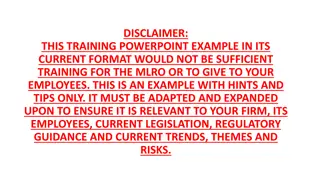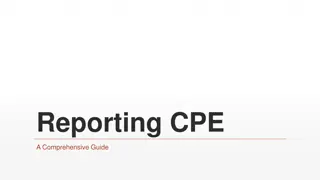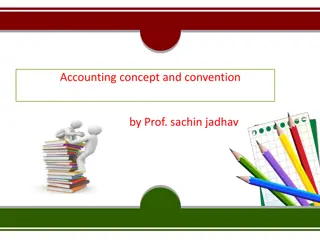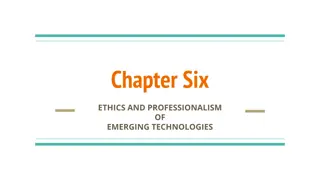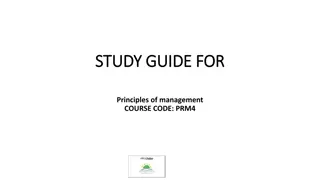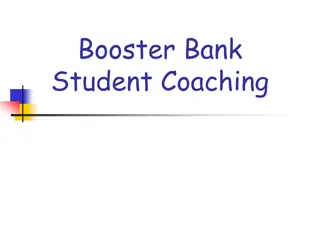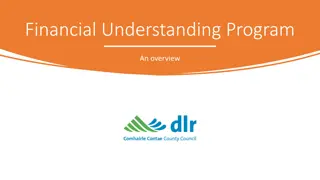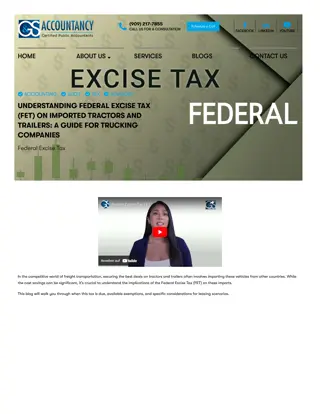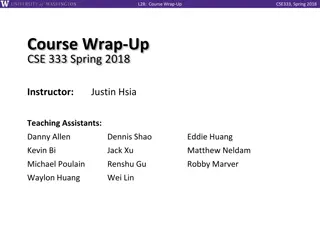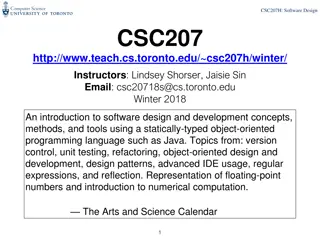Principles and Concepts of Accountancy Course
This course by Mr. B. Arunkumar covers fundamental accounting principles, concepts, and conventions essential for understanding and applying accounting frameworks. Topics include bookkeeping, final accounts, bills of exchange, consignments, joint ventures, bank reconciliation, and more. A variety of resources and recommended textbooks are provided for comprehensive learning.
Download Presentation

Please find below an Image/Link to download the presentation.
The content on the website is provided AS IS for your information and personal use only. It may not be sold, licensed, or shared on other websites without obtaining consent from the author.If you encounter any issues during the download, it is possible that the publisher has removed the file from their server.
You are allowed to download the files provided on this website for personal or commercial use, subject to the condition that they are used lawfully. All files are the property of their respective owners.
The content on the website is provided AS IS for your information and personal use only. It may not be sold, licensed, or shared on other websites without obtaining consent from the author.
E N D
Presentation Transcript
Goal: To enable the students to learn principles and concepts ofAccountancy. Objective: On successful completion of this course, the student should have understood ConceptsandConventionsofAccounting. BasicAccounting framework
Unit I Fundamentals of Book Keeping Accounting Concepts and Conventions Journal Ledger Subsidiary books Trial balance. Unit II Final accounts of a sole trader with adjustments Errors and rectification Unit III Bill of exchange- Accommodation bills Average duedate Account current.
Unit IV Accounting forconsignments andJoint ventures Unit V Bank Reconciliation statement Receipts and Payments and income and expenditure account and Balance sheet Accounts of professionals. * Note : Distribution of Marks between problems and theory shall be 80% and 20%.
1. N.Vinayakam, P.L.Mani, K.L.Nagarajan Principles of Accountancy S.Chand &CompanyLtd., 2.T.S.Grewal Introduction toAccountancy-S.Chand &Company Ltd., 3. R.L.Gupta, V.K.Gupta, M.C.Shukla Financial Accounting Sultanchand &sons 4.T.S.Grewal,S.C.Gupta,S.P.Jain AdvancedAccountancy-Sultanchand & sons 5. K.L.Narang, S.N.Maheswari publishers 6.S.K.Maheswari,T.S.Reddy - AdvancedAccountancy-Vikas publishers 7.A.Murthy -FinancialAccounting Margham Publishers 8. P.C.Tulsian - AdvancedAccountancy TataMcGrawHillCompanies. 9. A.Mukherjee, M.Hanif Modern Accountancy. Vol.1- Tata McGraw Hill Companies - Advanced Accountancy-Kalyani
Business entities and other organisations carry on activities which involve exchange of money or money s worthoreconomicresources. Where the volume of these activities are large in number it is necessary that these are recorded for the purpose of taking important decisions as to whether the activities are viable, gainful andareto becontinued ornot. Information about the business and other organisations is required not only to the proprietors and managers of business and other organisations but also to various other interested users such as the government, investors, customers,employees andresearchers.
In 1494, Luca Pacioli an Italian developed double-entry book- keeping system. Due to the industrial revolution in the 18th and 19th centuries, large scale operations were carried on and joint stock companies emerged as an important form of organisation which required separation ofownership from management. Hence, to safeguard the interest of owners and investors, the business establishments required detailed information about business which paved the way for development of comprehensive financial accountinginformation system. In the 20th century, the need for analysis of financial information for managerial decisionmaking ManagementAccounting asaseparate branch of accounting. caused emergence of
Accounting is the systematic process of identifying, measuring, recording, interpreting and communicating financial information. classifying, summarising, Accountinggives information on: (i) the resourcesavailable (ii) howthe available resourceshave been employed and (iii) the resultsachieved by their use. The profit earned or loss incurred during the accounting period, value and nature of assets, liabilities and capital can be ascertained from the information recorded in accounts.
AccordingtotheAmerican Institute of Certified Public Accountants Accounting is the art of recording, classifying and summarising in a significant manner and in terms of money, transactions and events which are in part, at least of a financial character and interpreting the resultsthereof . American Accounting Association has defined accounting as the process of identifying, measuring, and communicating information to permit informed judgements and decisions byusersoftheinformation . economic
Preparing Final A/c Opening Entry/ (Trading, P&L A/C and Balance Sheet) Transactions Preparing Trial Journalising Balance Posting and Balancing (Ledger)
To keep a systematic record of financial transactions and events To ascertain the profit or loss of the business enterprise To ascertain the financial position or status of the enterprise To provide information to various stakeholders for theirrequirements Toprotectthepropertiesof an enterpriseand To ascertain the solvency and liquidity position of an enterprise
Measurement Forecasting Comparison Decision making Control Assistance to government
Systematic records Preparation of financial statements Assessment of progress Aid to decision making Satisfies legal requirements Information to interested groups Legal evidence Computation of tax Settlement during merger
Financial Accounting Human Cost Resources Accounting Accounting Accounting Social Management Responsibility Accounting Accounting
There are three bases of accounting in common usage,namely i.Cashbasis ii.Accrualor mercantilebasis iii.Mixedor hybridbasis.
Internal Users i. Owners ii. Management iii. Employees External Users i. Creditors and financial institutions ii. Investors iii. Customers iv. Tax authorities and regulatory bodies v. Government vi. Researchers vii. General public
Protector of business assets Public relation officer Financial advisor Record keeper Provider of information Tax manager
The first step in the accounting process is identifying and recording of transactions in the books ofaccounts. In a broad sense, accounting includes book- keepingalso. In a small business, the entire accounting work may beperformedby asingle accountant. In a large firm, there may be a separate person or departmentforbook-keeping work.
Book-keeping is the process of recording financial transactions in the books of accounts. It istheprimarystagein theaccounting process. It includes recording the transactions and classifying the same under properheads. Book-keeping work isofroutinenature. Transactions may be recorded in the accounting note books and ledgers or may be recorded in a computer.
Book-keeping is an art of recording business dealingsinaset ofbooks . -J.R.Batliboi. Book-keeping is the science and art of recording correctly in the books of account all those business transactions of money or money sworth . -R.N.Carter.
i. It is the process of recording transactions in thebooks ofaccounts. ii. Monetary transactions only are recorded in theaccounts. iii. Book-keeping is the primary stage in the accountingprocess. iv. Book-keeping includes journalising and ledgerprocessing.
i. To have a complete and permanent record of all business transactions in chronological order and underappropriateheadings. ii. To facilitate ascertainment of the profit or loss of thebusinessduringaspecificperiod. iii.To facilitateascertainmentoffinancialposition. iv.To knowtheprogress ofthebusiness. v.Tofindout thetaxliabilities. vi.To fulfilthelegalrequirements.
i. Transactions are recorded systematically in chronological order in the book of accounts. Thus, book-keeping provides a permanent and reliable record for all business transactions. ii.Book-keepingisusefultogetthefinancial information. iii.It helpsto havecontrolovervariousbusinessactivities. iv. Records provided by business serve as a legal evidence in caseof any dispute. v. Comparison of financial information over the years is possible. Also comparison of financial information of differentbusinessunitsisfacilitated. vi.Book-keepingisuseful tofind outthetax liability.
i. Only monetary transactions are recorded in the books ofaccounts. ii.Effectsofpricelevelchangesarenotconsidered. iii. Financial data recorded are historical in nature, i.e.,onlypastdataarerecorded
S. No Basis of distinction Book-keeping Accounting 1 Scope It is concerned with recording and classifying the business transactions. It is concerned with recording, classifying, summarising, analysing and interpreting the financial data. 2 Stage Book-keeping is the primary stage in accounting. It is the base for accounting. Apart from the primary stage, it includes secondary stage of analysis and interpretation. 3 Nature of job It is routine and clerical in nature. It is analytical in nature. 4 Knowledge required It requires basic knowledge of the principles of journalising and posting. It requires thorough knowledge of accounting principles, procedures and practices. 5 Skill required Analytical skill is not required for book-keeping. It requires analytical skill.
Book-keeping is part of Accounting. It is the primary stagein accounting. It is the process of recording transactions in the books ofaccounts. AccountingispartofAccountancy. Accounting is the process of reording, classifying, analysing and interpretingof financial data. Accountancy is the systematic knowledge of accounting process and contains the standards, principles, policies and procedures to be followed in accounting.
Accounting principles are the basic norms and assumptions developed and established as the basis for accounting system. These principles are adopted by the accountants universally. These accounting principles provide uniformity and consistency in the accounting methods and process. Such accounting principles are known as Generally Accepted Accounting Principles (GAAP).
(i) Business entity concept (ii) Money measurement concept (iii) Going concern concept (iv) Cost concept (v) Dual aspect concept (vi ) Periodicity concept (vii) Matching concept (viii) Realisation concept (ix) Objective evidence concept
(x) Accrual concept (xi) Convention of consistency (xii) Convention of full disclosure (xiii) Convention of materiality (xiv) Convention of conservatism or prudence






